The 2012 MacBook Air (11 & 13-inch) Review
by Anand Lal Shimpi on July 16, 2012 12:53 PM EST- Posted in
- Apple
- Mac
- MacBook Air
- Laptops
- Notebooks
The Display
The MacBook Air is really Apple's mass-market notebook, and as such it's not going to be the target for a Retina Display upgrade, at least not this year. While technically feasible, my guess is a lack of supply kept a rMBA out of the cards for this year. There's also the matter of maintaining its thin profile and battery life in pursuit of a retina display.
The MacBook Air display continues to be good, and better than most, but no where near what the rMBP delivers and actually a step behind what the competition in the PC space has been cooking up.
If there was one clear trend at Computex this year it's towards IPS 1080p displays in Windows 8 notebooks. ASUS actually pre-empted all of the exciting announcements (rMBP included) with its Zenbook Prime, complete with 11 and 13-inch 1080p IPS displays. As the MacBook Air retains its TN display, for the first time we can actually say that ASUS' Ultrabook offers better viewing angles than the Air. The difference is quite noticeable:
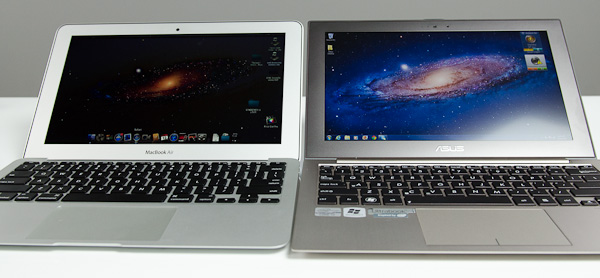
2012 MacBook Air (left) vs. 2012 ASUS Zenbook Prime (right)
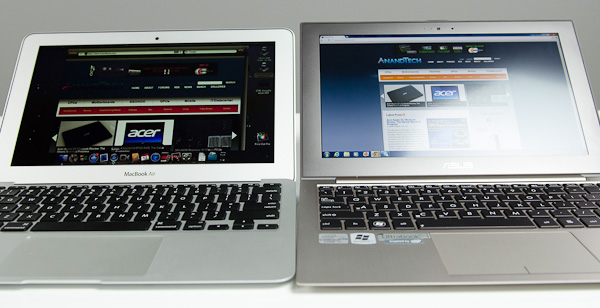
2012 MacBook Air (left) vs. 2012 ASUS Zenbook Prime (right)
ASUS also enjoys a resolution advantage, but it's not really high enough to make good use of integer DPI scaling (at 2x you get a UI sized for a 960 x 540 display). You get sharpness, and additional desktop area, but not the total package you get with the rMBP. There's no denying that what ASUS has done is better, it's just not perfect. And as Apple has shown us in the past, it's not fond of stopgap solutions.
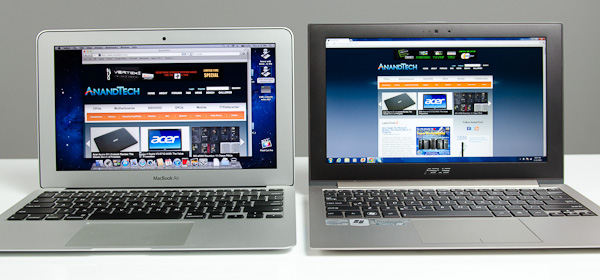
2012 MacBook Air (left) vs. 2012 ASUS Zenbook Prime (right)
Brightness, black levels, contrast, color accuracy and gamut haven't changed over the past year. The MacBook Air's panel remains one of the best non-IPS solutions on the market. The problem is that consumer insistence higher quality displays has pushed Apple's competitors to finally deliver more than TN at MacBook Air price points. Sooner rather than later, Apple will have to respond.
The Panel Lottery
Unlike in previous years, there appears to be three manufacturers supplying panels for the 2012 MacBook Air. LG Philips and Samsung return from before, but AUO now joins the fray. It's quite possible that Apple's volumes have grown large enough to justify adding a third supplier - a trend we may see increase in the future, and across more component categories.
As always, you can try to find out what panel is used in your MacBook Air by executing the following command in an OS X Terminal window:
ioreg -lw0 | grep IODisplayEDID | sed "/[^<]*</s///" | xxd -p -r | strings -6
The output will look something like this:

As long as Apple hasn't masked the data, the first line should be the part number of your display panel. The first one or two characters will tell you the manufacturer: LP for LG Philips, LT for Samsung and B for AUO. Anecdotally, LG and Samsung seem to be the most prevalent. In my personal experience with six 13-inch 2012 MacBook Airs and three 11-inch MacBook Airs, the breakdown was as follows:
13-inch $1499 - Samsung
13-inch $1499 - Samsung
13-inch $1499 - Samsung
13-inch $1499 - Samsung
13-inch $1499 - Samsung
13-inch $2199 - LG
11-inch $1099 - AUO
11-inch $1099 - AUO
11-inch $999 - Samsung
A thread over on Macrumors places the Samsung/LG split much closer to 50/50, however it's not clear if there's a higher incidence of LG panels in BTO or non-default configurations. We'd need many more samples to really get an idea for how all of this shapes up, so don't put too much faith in the results from my experience.
Apple does its best to ensure that all three panels deliver comparable performance, however there are differences. Let's first start with the numbers:
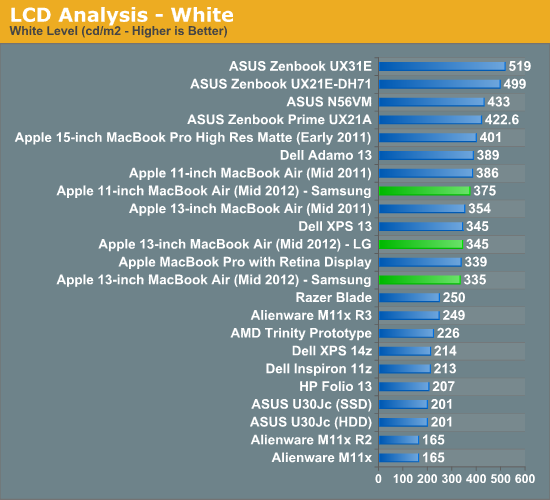
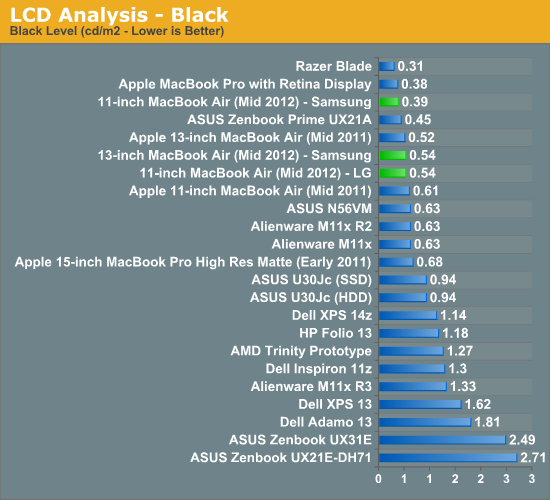
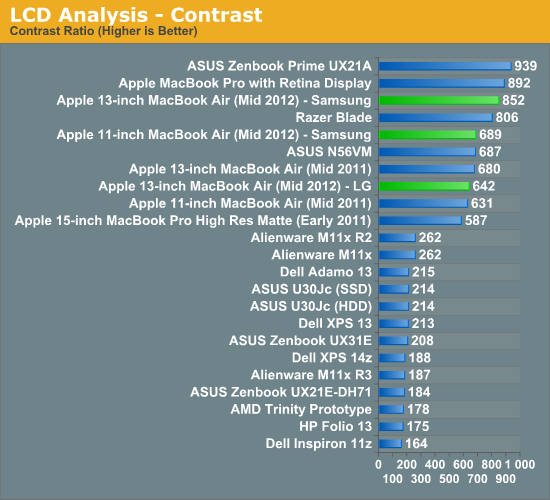
The 13-inch LG panel delivers tangibly worse black levels than the Samsung alternative. There's even a pretty dramatic difference in black levels between even the 11 and 13-inch Samsung panels. It's also possible that there's panel to panel variation at play here that would result in this sort of a difference.
The LG panel is a bit brighter, which helps it reach a decent contrast ratio but the 13-inch Samsung panel's low black levels give it an advantage. Interestingly enough, the 13-inch LG sample performed very similarly to the 11-inch Samsung. I really do wonder how much of this difference is just normal variance between panels.
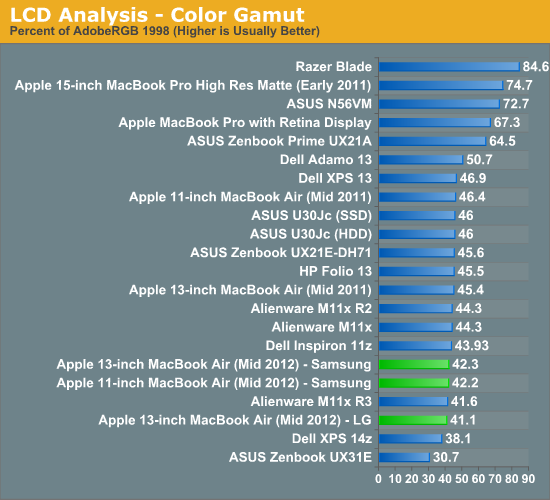
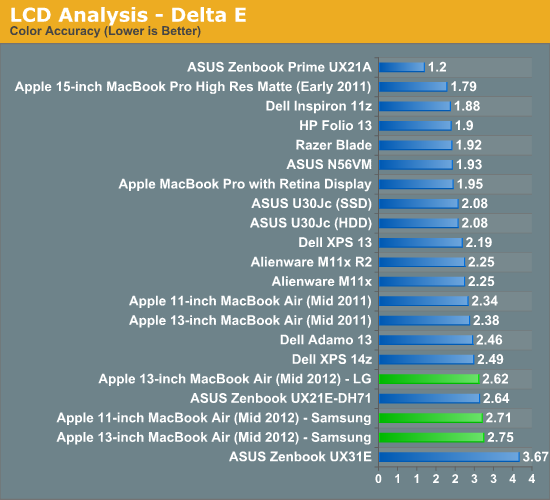
Color accuracy is slightly better on the LG panel, although it's not beyond the noticeable threshold. Color gamut is comparable between the displays.
Independently, neither the Samsung or LG panels is particularly bad to look at. These are still TN panels so you get poor vertical viewing angles, but the quality is still better than the cheaper TNs we often see used in less expensive notebooks. It's when you compare the two or you're used to one that you can really tell a difference: the Samsung panel, particularly when displaying black text on a white background, looks better than the LG.
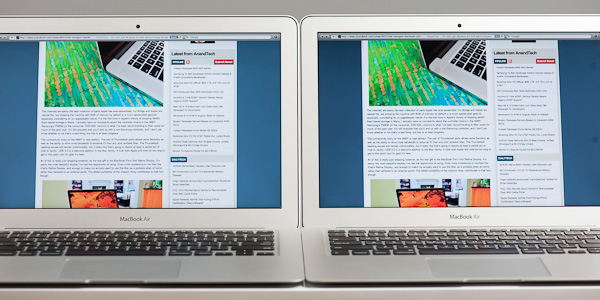
13-inch LG LP133WP1-TJA3 panel (left) vs. Samsung LTH133BT01A03 panel (right)
I had some friends over and tossed them a pair of 13-inch MBAs. One had the LG panel and one had the Samsung panel. They used the MBAs and swapped after a short while. Almost instantaneously they could tell the difference between the panels. Everyone significantly favored the Samsung.
I was actually a bit surprised how quickly they noticed the difference. With these type of things I always assume I'm just more sensitive than most, but in this case the difference was noticeable enough to pick out. Everyone added (and I agreed) that the difference was most pronounced because they were able to switch between two. In a vacuum each one seemed fine.
I tried my best to capture the difference between the two panels on camera. The easiest way to describe the difference is text on the Samsung panel just looks darker (mouse over the panel name in the table below):
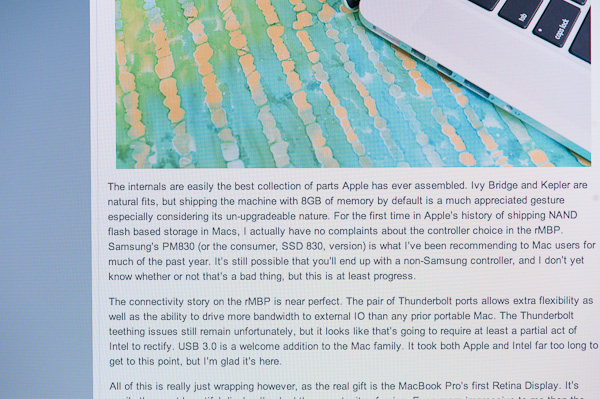
| LG LP133WP1-TJA3 | Samsung LTH133BT01A03 |
| original | original |
Just like last time, I believe the two panels behave differently in how they react to off-center viewing angles but I couldn't really capture the slight differences on camera. Although I didn't have an AUO equipped MBA on hand, the one I saw in an Apple store looked closer to the LG than the Samsung.
The good news is after a calibration pass using Color Eyes Display Pro, the difference between the two is significantly reduced - to the point where I can no longer tell the two apart:
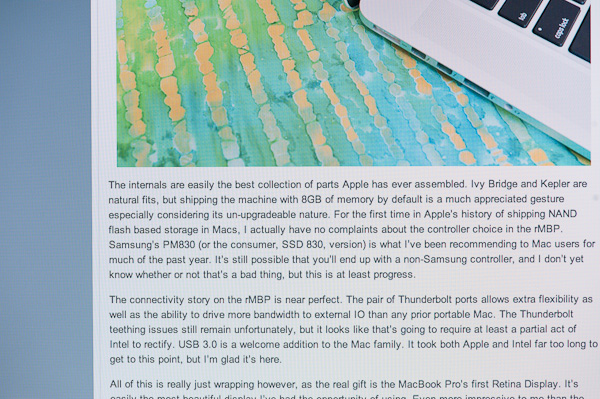
| LG LP133WP1-TJA3 | Samsung LTH133BT01A03 |
| original | original |
The obvious problem with this solution is you need access to a decent colorimeter or spectrophotometer and calibration software. There are some color profiles floating around the web that may help (I've uploaded mine for the LG here, Samsung here) but every panel is going to be at least somewhat different so this is still not perfect.
Subjectively, I'm fine with the LG panel, although I do like the look of the Samsung better. Both are a bit of a disappointment compared to what you get from the Retina Display in the MacBook Pro however. It's just presently what you give up for portability and cost.
To Make a Retina
The thing about the MacBook Air is that it's already quite minimized on the inside. The vast majority of the chassis is occupied by a battery, and there's no traditional HDD or optical drive to remove for additional space. Apple can't simply toss a much higher resolution panel on the system and call it a day, at least not without a tangible reduction in battery life.

13-inch MacBook Air (Mid 2012) - iFixit
Apple had to give the MacBook Pro with Retina Display a 95Wh battery (up from 77.5Wh) just to deliver similar battery life to the regular MacBook Pro. The higher resolution display requires a brighter backlight to push light through the panel and maintain comparable brightness levels.
The motherboard itself can stand to lose a single chip (the PCH) with the transition to Haswell, but that's not going to give us a ton of space either.
In the short term Apple could opt for a slightly thicker chassis (similar to what happened in the 3rd gen iPad) to accommodate a larger battery. Eventually the hope is that panel efficiency will increase to the point where we won't need significantly brighter backlights.


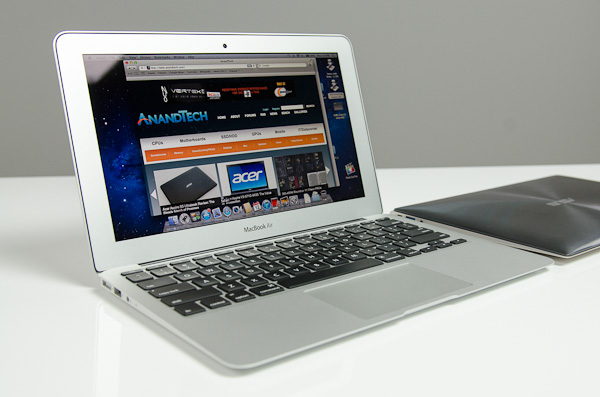








190 Comments
View All Comments
Osamede - Tuesday, July 17, 2012 - link
This Y5 was highly portable. If you never used one you have no idea. It was wedge shaped. And the shape allowed for durablity. It was military grade and rated to survive a drop of several feet. And yes STILL only 3.5 lbs, In 2004.Besides its now 2012, give us a call when Apple manages to bring to market a 14" laptop with optical drive at 3.5 lbs.. Only God knows the kind of hype we would have heard it it was Apple doing what Panasonic managed damn near a decade ag.
There was also the even smaller Panasonic W series and before that Sharp had some really good products with the Actius series at really good prices. And now thats going back to probably 1998 or even earlier
Of course Apple fanboys imagine that the world began when Apple launched the MacBook Air. Pschew.....
KPOM - Tuesday, July 17, 2012 - link
Apple isn't going to make any more notebooks with optical drives. Once the classic MacBook Pro is phased out, optical drives are history at Apple. If you notice, most Ultrabooks lack them, as well.A wedge design topping out at 1.9" thick is still pretty bulky. Obviously it was designed for a niche audience, since they aren't selling them anymore. From the specs in 2007 it had a Core Duo 1.66GHz, topped out at 1.5GB RAM, and was very expensive. The keyboard also looks cramped.
http://www.trustedreviews.com/Panasonic-ToughBook-...
I'm not disputing that there were ultraportables before the MacBook Air. Heck, I've even pointed to the PowerBook Duo. I've always been a fan of ultraportables and though they were a long-neglected category. Apple itself didn't have one for 2 years after the 12" Powerbook was dropped.
Most ultraportables were slow sellers that were quietly abandoned. To its credit, Apple stuck with the MacBook Air. A lot of Apple fans were even calling for Apple to drop the MacBook Air as late as September 2010. However, they stuck with it and continued to perfect the design. It's indisputable that the release of the $999 11.6" MacBook Air in October 2010 launched the concept of a mainstream ultraportable.
Osamede - Friday, July 20, 2012 - link
Nice try with the red herring about optical drive.The Panasonic was 3.5 lbs with Optical dive. Take that weight out and you have a 14" laptop with 1400 x 1050 at 3.2 lbs.....in 2006.
And yet according to you we are all supposed to roll over in supplication because in 2012 Apple is selling 13" laptops that weight 3lbs. Spare me the hype. Even The 2010 Sony Z is already a superior laptop compared to even todays "latest" MacBook Air, let alone the 7 year old Panasonic model.
Some of you swallow marketing BS and think it is fact.
KPOM - Friday, July 20, 2012 - link
Red herring? You are the one claiming that Apple should be putting in optical drives if they want to brag. My point is that optical drives are mostly passé. Intel hasn't made it part of the Ultrabook standard. Sony's Vaio Z is an impressive machine, but at more than twice the cost of the base MacBook Air it had better be.I'm not saying we need to roll over in supplication. What I am saying is that Apple transformed the ultraportable from a niche device to a mainstream device. My whole point, which your red herring about Panasonic Toughbooks and Sony Vaios ignores, is that ultraportables had been around for a decade but weren't popular devices until Apple got the formula right. Maybe Panasonic could have made a 14" laptop with 1400x1050 at 3.2lbs in 2006, but they didn't. Maybe Sony could have made a $999 Sony Vaio in 2010, but they didn't. Apple DID make a $999 MacBook Air in 2010. Apple DID make an ultraportable with a full size keyboard and super slick trackpad in 2008, and they DID make it affordable in 2010, and they DID take the drastic step of dropping hard drives and going exclusively with SSD storage in 2010.
phillyry - Tuesday, March 26, 2013 - link
You can't just say that this other laptop was lighter than it actually was because it would be lighter if it didn't have an optical drive that it did have. Confused much? That's because it doesn't make sense. Your logic is flawed. It either had the drive and the weight and bulk that go with it (as it did) or it didn't (as in your imaginary best case).phillyry - Tuesday, March 26, 2013 - link
Also, Apple is phasing out the optical drive. No red herring there.KPOM - Tuesday, July 17, 2012 - link
"Of course Apple fanboys imagine that the world began when Apple launched the MacBook Air. Pschew..... "Actually a lot of "Apple fanboys" HATED the original MacBook Air.
Read some of the comments to this article: http://www.macworld.com/article/1131583/macbookair...
As for optical drives, it's 2012. Did you complain when Apple stopped supporting the floppy drive, too? I don't see any optical drives on Microsoft's Surface Pro.
phillyry - Tuesday, March 26, 2013 - link
The devices you refer to were not mainstream.will54 - Monday, July 16, 2012 - link
"While 1440 x 900 is a bit much on a 15-inch MacBook Pro, I'd say it's near perfect on the 13-inch Air. If Apple were to do the Retina treatment on here, it'd be magnificent." This line is a bit confusing, can you explain further?Tegeril - Tuesday, July 17, 2012 - link
I assume he intended to mean that the 15" screen is too large for 1440x900 as the pixels are quite large, but on a 13" screen it is ideal.